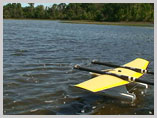An unmanned seaplane with a seven foot wingspan has been developed at the University of Michigan. The autonomous craft is believed to be the first seaplane that can initiate and perform its own takeoff and landing on water.
Flying Fish, an electric vehicle, drifts until its onboard Global Positioning System tells the craft it has floated too far. That triggers a takeoff sequence, which gets the plane airborne in just 10 metres. Other GPS coordinates trigger the landing sequence.
The craft accomplishes both in simple ways, explained Ella Atkins, associate prof of aerospace engineering at the university.
The flight pattern is, for the most part, a recording of a graduate student's piloting of the plane. That means the takeoff is blind, Atkins explained. The plane takes no measurements of its surroundings as the waves would confuse it.
'The plane puts the motors on at full throttle and sets the pitch elevator enough to break out of the water. We believe that if we had done it any other way, we would have basically dived into the ocean on takeoff because the plane would have detected huge oscillations due to the waves,' Atkins said.
The landing is basically a shallow descent. 'Because it doesn't have a flat bottom, it cuts into the water like a diver, as opposed to belly-flopping,' he added.

Next, the team plans to outfit the plane with solar power and add more sensors.
Funded by the US Department of Defense's Defense Advanced Research Projects Agency (DARPA), the craft is designed to advance the agency's 'persistent ocean surveillance' program.
For more information on the Flying Fish project at the U-M Marine Hydrodynamics Laboratories, click here.




Red Bull makes hydrogen fuel cell play with AVL
Formula 1 is an anachronistic anomaly where its only cutting edge is in engine development. The rules prohibit any real innovation and there would be...